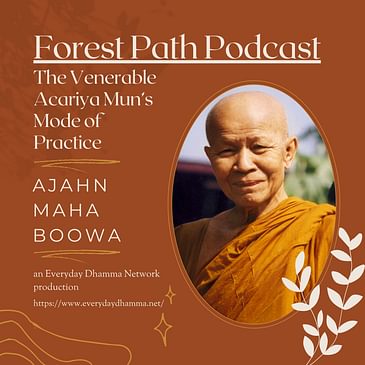This episode is a talk given by the Thai forest meditation master Ajahn Maha Boowa and is titled “The Venerable Acariya Mun’s Mode of Practice”. It was first publish as part of the book “kammaṭṭhāna - the basis of practice” which was translated by monks at Wat Pah Ban Taad.
For free distribution
No part of this teaching may be reproduced in any form of by any means, electronic or mechanical, including photocopying, without permission in writing from the publisher unless it is to be reproduced for Free Distribution, in which case, permission is freely given.
Links
THE VENERABLE ĀCARIYA MUN’S MODE OF PRACTICE The nature of the Venerable Ācariya Mun’s mind was quite dynamic, quick and sensitive to the various events with which it came into contact. In the beginning of the practice of bhāvanā he used ‘buddho’ as the parikamma object. When the citta converged into calm there arose a picture-nimitta, sometimes of himself lying dead and sometimes of remnants of a corpse that seemed lying in front of him. He therefore took up these images as the objects of bhāvanā. Sometimes he would establish them to appear loathesome (paṭikūla) by various techniques which depend on the proficiency and skillfulness of sati-paññā to devise. It would sometimes be totally broken up leaving just the skeleton, and sometimes these bones would be collected together in a heap and burned down to ashes. The picture-nimitta of himself lying dead and the remnants of a corpse were all established by the same method. They appeared at different times, only depending on the suitability of the investigation that was being carried out at that time. After having established the fire burning the bones to ashes, his citta converged fully to the base of samādhi where it rested for hours before withdrawing. When the citta withdrew, he continued with the establishing. He said that from the day the citta experienced the picture-nimitta – and the establishing of the nimittas into various appearances according to his wish, together with the ability to burn the remnants of the corpse at any time – he constantly established the remnants of the corpse with just the skeleton remaining with him at all times. It remained with him regardless of whether he was standing or walking, sitting or lying down – excepting only the time when he was investigating the corpse by the various techniques or when the citta converged into samādhi and rested alone. During this time there was no concern for any other things. The strength of his citta could be clearly seen to progress – and his base of samādhi to become firmly established – due to his consistent acquisition of the nimitta as the sharpening stone for discernment (sati-paññā). He was able to establish the mental image (nimitta) of the skeleton within himself. He and the skeleton became one and the same, until there was no question concerning the origin of this skeleton or who became this skeleton. He then dispensed with this way of establishing, for once the nimitta had become himself it was no longer necessary to send the citta to establish the external picture. From then on, he used the body as the basis of investigation. It was up to the proficiency and skillfulness of sati-paññā to decide the aspects as to how the body should be investigated. The investigation was then carried on as he wished. He said that, during this time, his concentration was very firm and stable due to investigating the body with paññā until the citta very easily converged into samādhi. The parikamma object of ‘buddho’ (that originally was used to direct the citta) was given up the very day that the picture-nimitta clearly appeared. He then used both the nimitta and the parikamma object of ‘aṭṭhi’ (bones) as the ārammaṇa of the Heart in place of ‘buddho’. There was only establishing and investigating the states of integration, change, and dissolution of the body in every posture excepting only the time of sleep. This continued until his body, although really still there, turned into the space element due to the power of investigation. The citta was devoid of all materiality such as the body. This was due to the power of discernment (sati-paññā) which relentlessly investigated without pause. He was very skilled in every level of samādhi and just as proficient and quick in the vipassanā (investigation) of rūpa-dhamma (the body, both one’s own and others’). He said that the vipassanā of this level caused the citta to become very bright and marvellous. If one is not mindful and discerning one might enjoy this happiness and comfort, to the point of forgetting to develop more penetrating insight (paññā). One could become unknowingly addicted to this state of voidness, because one might think that it was definitely Nibbāna. For one had constantly heard, until it was deeply embedded in one’s Heart, that Nibbāna was just the state of emptiness. But one didn’t know what the characteristic of Nibbāna’s voidness was. With that specific emptiness that had appeared, one didn’t know if there was anything hidden within it, for in truth it was just the very subtle and mysterious delusion (kilesa) of one’s Heart, rather than the emptiness of Nibbāna. Before one can pass beyond the rūpa-dhamma – by using the various techniques of investigation – sati-paññā must revolve around the body nearly all the time. The exception being the time when the citta, after having investigated and analysed, becomes very tired due to its work and exertion and rests calmly in samādhi. When it withdraws, restrengthened, it then continues on with this work of body analysis, having the Ti-lakkhaṇa 9 as the way. This is because the body is an important object in the circle of practice and the more one is proficient and skillful in the investigation of the body, the more one will be bold and fearless in one’s practice. For the body is the source and home of the coarser kinds of sexual craving (rāga-taṇhā) and wrong view (māna-diṭṭhi). They take up residence openly and, in some cases, manifest themselves in a very coarse and disgusting manner. Even amongst those who have kilesas, it is found to be distasteful and unbearable to the point of being sickening. For this reason, the practitioner who endeavours to destroy the kilesas must concentrate on the body analysis (kāya–vibhāga) until becoming proficient, adept and capable of definitely cutting out sexual craving (rāga-taṇhā) at all times. The kilesa of wrong view (māna-diṭṭhi) is much more piercing and adverse to both oneself and others than any other kind of kilesa because it manifests itself so quickly, essentially depending on attachment (upādāna) to the body. It is taught that one should investigate the body (‘kāyagatāsati’ in the Four Satipaṭṭhāna) and the Four Noble Truths (Ariya Sacca) 10, for these are the most important dhammas in the circle of the religion. This should be done a lot, until all doubts disappear. Then one will pass beyond, without any trace of yearning remaining. The Venerable Ācariya Mun was very proficient and adept in mindful investigation of the body (kāyā-nupassanā- satipaṭṭhāna), and therefore very proficient in the various dhammas both internal and external – more so than the other practitioners. He said that once beyond the body, there were no longer any problems with lust (kāma-rāga) – without having to ask anyone else about it. This is wasting one’s time and showing one’s stupidity for others to laugh at, for it is something within oneself. By the thoroughness of the insight (sati-paññā) of this level, it disappears from oneself. The Heart can live quite comfortably without having any troubles when just this sexual craving (rāga-taṇhā) is destroyed. This is because rāga-taṇhā is a thing that consumes without ever coming to satisfaction. It constantly disturbs and incites the Heart making one become cowardly, lacking in courage, easily disheartened and weak in one’s way of practicing for magga, phala, and Nibbāna. For these are within the circle of Sacca-Dhamma (the True Dhamma) and satipaṭṭhāna (the establishment of mindfulness), which the one who practises can reach with persevering effort. The Venerable Ācariya Mun said that before the body ceased to be a problem for investigation, all the aspects of the body that were being investigated by the various techniques converged together into the Heart. The aspects (sankhāra) on the side of suffering’s cause (samudaya) – which from the beginning had thought of the body as beautiful, pleasant and pleasing – and those on the side of the path (magga) – which conceived the body as unpleasant, repulsive, loathsome (paṭik- kūla), impermanent (aniccaṁ), unsatisfying (dukkhaṁ), and not-oneself (anattā) – both ceased at the same moment when the image of the body converged into the Heart. The pleasant and beautiful (subha) and the unpleasant and repulsive (asubha) diverged, leaving a way for the Heart to pass through without any yearning between the two. No more were there nimittas to follow and deceive with their pleasant and unpleasant aspects. Every time he investigated, he just saw the mind create the image within and then it ceased – only that. From then on, the citta was devoid of the various kinds of materiality: both that of the body and the external material that existed everywhere. There was no sign (nimitta) to label them as beautiful or repulsive as there had been in the past. There was just brightness and the citta totally devoid of all things. It just revolved with thoughts and reflections, with mindfulness as the guiding factor. The next targets for sati-paññā to concentrate on were the dhammas that arose and ceased within the heart: vedanā, saññā, sankhāra, viññāṇa, and, finally, avijjā – the origin of all the kilesas.




